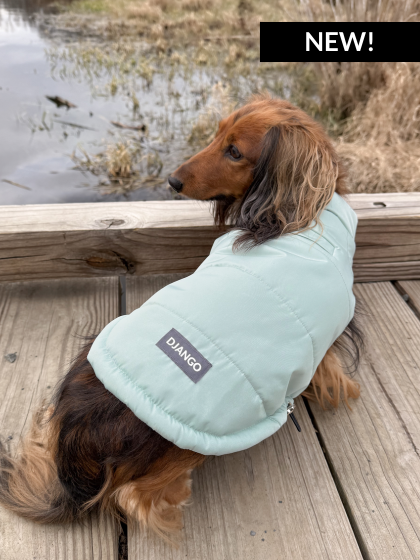Are you planning on jumping in an inviting lake as the weather warms? Or letting your dog wade into a shallow river bed during a weekend hike? Before you and your pup freely jump into the water, make sure you are aware of the most common waterborne bacteria and parasites.
Giardia
What is it?
Giardia is a parasite that can cause intestinal infections in both humans and animals. Puppies are more prone to infection than older dogs and should have their feces tested at their first vet visit. Antibiotics fortunately exist to rid giardia in dogs.
Where is it found?
Giardia is found all over the world and is an extremely common causes of waterborne disease. According to the Mayo Clinic, “the parasites are found in backcountry streams and lakes but also in municipal water supplies, swimming pools, whirlpool spas and wells.” Dogs usually acquire giardia after drinking contaminated water or coming in contact with another animal’s infected feces.
How to avoid it
Always provide clean drinking water and never allow your dog to get too close to another animal’s feces.
Cryptosporidium
What is it?
Cryptosporidium is an intestinal microscopic parasite that can cause gastrointestinal discomfort, fever and diarrhea in dogs. The parasite is spread via contaminated drinking and recreational water. The CDC confirms “cryptosporidium is a leading cause of waterborne disease among humans in the United States”. It is also a top intestinal parasite affecting dogs.
Where is it found?
The CDC confirms that “cryptosporidium parasites are found in every region of the United States and throughout the world. Travelers to developing countries may be at greater risk for infection because of poorer water treatment and food sanitation”. The U.S. population alone sees over 700,000 cases of cryptosporidiosis each year.
How to avoid it
Bring clean water for your dog whenever you adventure. This will prevent him from drinking out of dirty pools of water. Additionally, try to prevent your pup from drinking from a communal water source (i.e. a dog bowl outside a store). The crypto parasite can easily be ingested from contaminated water.
Schistosomiasis
What is it?
Schistosomiasis is a disease caused by waterborne parasitic worms. Dogs can become infected by swimming or wading in contaminated water.
Where is it found?
The majority of canine schistosomiasis cases occur in Texas and Louisiana. That said, the Companion Animal Parasite Council reports “cases have been diagnosed in dogs throughout much of the southeastern United States, and infections are also described from dogs as far north as Kansas.”
How to avoid it
Dogs in the southeastern part of the United States should avoid ponds, canals, and other waterways with limited flow. Additionally, do your research before letting your pup jump into a body of water, i.e. visit the lake/pond/swimming hole state or government website and review any water alerts or cautions.
Blue-Green Algae (Cyanobacteria)
What is it?
A microbacteria that can accumulate in lakes, streams, ponds and brackish water bodies. Under the right settings - stagnant water, sunlight and high water temperatures - cyanobacteria can accumulate rapidly into algal “blooms”. Some of these blooms produce dangerous toxins that can cause liver damage or harm the nervous system.
Where is it found?
Cyanobacteria can be found all over the world; it is not specific to one type of climate or region. The bacteria often accumulates in calm areas of lakes, streams, ponds and brackish water bodies and thrives in hot temperatures (for this reason it is most commonly found during the warmer spring, summer and fall months) .
How to avoid it
Avoid water that is foamy, scummy, or has a thick blue-green-red film floating on top. Many states publish algal bloom adversaries online, so research a body of water before jumping in. Finally, never allow your pup to drink out of stagnant water, especially if it has blue-green scum floating around the edges. Minimize this risk by always having clean drinking water on hand.
For more in depth details on cyanobacteria, see our recent blog post The Dangers of Blue Green Algae (Dangerous Waters: Part 1)
Leptospira
What is it?
Leptospira is a bacteria that causes the disease Leptospirosis in humans and animals. Symptoms vary and may not even show up in infected beings. According to the CDC, “without treatment, Leptospirosis can lead to kidney damage, meningitis (inflammation of the membrane around the brain and spinal cord), liver failure, respiratory distress, and even death.”
Where is it found?
Leptospira is commonly found in tropical, subtropical and wet environments, but it can technically live anywhere (i.e. it’s been found in stagnant water in New York City). Warm marshes, swamps and stagnant pools are common homes to the bacteria.
How to avoid it
Dogs in that frequently swim or play in infected water, soil and mud (particularly in tropical/subtropical climates) are at greatest risk of infection. Avoid letting your pup swim in a body of water unless you are familiar with the area. Also consider the Lepto vaccine. Although the American Veterinary Medical Association does not consider this a “core vaccine” (meaning it is not appropriate for all dogs in all communities), it may make sense for your pup depending on your surrounding environment. Speak to your local vet to learn about the risk of Leptospirosis in your area and if the vaccine is right for your dog.
Pseudomonas
What is it?
Pseudomonas is a common bacteria that can cause chronic pseudomonas otitis, or chronic ear infections, in dogs. It can also cause skin infections. The bacteria is resistant to many antibiotics, so veterinarians often have a difficult time treating infected dogs. Dogs with pseudomonas otitis will often display the following symptoms: head shaking or ear scratching, discomfort when ear area is touched, ear inflammation and pain, and discharge from the ear.
Where is it found?
Pseudomonas is able to thrive in a number of environments (i.e. water, soil, man-made tools) and is found throughout the world.
How to avoid it
According to the AESCA, pseudomonas bacteria can thrive in pools and hot tubs “possibly due to excessive warmth and moisture of the skin causing increased susceptibility to infection”. For this reason, never let your dog play for extended periods of time in pools and hot tubs. Young and old dogs are particularly susceptible to pseudomonas infections given their immature/weak immune systems.
Additional resources
Check out DJANGO's additional resources on water safety for dogs:













